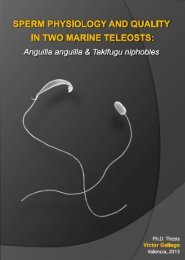TESIS DOCTORAL - RiuNet - Universidad Politécnica de Valencia
TESIS DOCTORAL - RiuNet - Universidad Politécnica de Valencia
TESIS DOCTORAL - RiuNet - Universidad Politécnica de Valencia
Create successful ePaper yourself
Turn your PDF publications into a flip-book with our unique Google optimized e-Paper software.
Chapter 1<br />
traditionally reported as the causal agents of basal rot or root necrosis on grapevines.<br />
Nevertheless, this disease was already named as “pied noir” in French language since<br />
1969, because of the presence of black necrosis on the base of diseased rootstocks<br />
(Badour, 1969).<br />
The first report of “C.” <strong>de</strong>structans on grapevine was ma<strong>de</strong> in France in 1961<br />
(Maluta and Larignon, 1991). Since then, it has been isolated from diseased vines in<br />
Italy (Grasso, 1984), Portugal (Rego et al., 2000), Argentine (Gatica et al., 2001),<br />
Germany (Fischer and Kassemeyer, 2003), Pennsylvania (Gugino and Travis, 2003),<br />
New Zealand and South Africa (Halleen et al., 2004), Brazil (Garrido et al., 2004),<br />
California (Petit and Gubler, 2005) and Canada (Petit et al., 2011). “Cylindrocarpon”<br />
obtusisporum, has also been reported to produce black-foot symptoms on grapevine in<br />
Sicily (Grasso and Magnano di San Lio, 1975) and California (Scheck et al., 1998a).<br />
The generic name “Cylindrocarpon” was introduced in 1913 by Wollenweber<br />
for anamorphs belonging to Nectria section Willkommiotes Wollenw. This section<br />
inclu<strong>de</strong>d species without chlamydospores. Few years later, in 1917, Wollenweber<br />
expan<strong>de</strong>d the concept of “Cylindrocarpon” to inclu<strong>de</strong> species forming mycelial<br />
chlamydospores in culture, being “C.” <strong>de</strong>structans the most important member of this<br />
group (Brayford, 1993). In 1966, Booth split the genus into four groups based on the<br />
presence or absence of microconidia and chlamydospores: (i) “Cylindrocarpon”<br />
magnusianum (Sacc.) Wollenw., which is the anamorph of the type species of<br />
Neonectria, (ii) “C.” cylindroi<strong>de</strong>s Wollenw., which is the type species of the genus<br />
“Cylindrocarpon”, (iii) “C.” <strong>de</strong>structans, which is the anamorph of Neonectria<br />
radicicola, and (iv) members of “Cylindrocarpon” species predominantly connected<br />
with teleomorphs of the ‘Nectria’ mammoi<strong>de</strong>a group (Brayford, 1993; Halleen et al.,<br />
2006a). “Cylindrocarpon” obtusisporum was originally <strong>de</strong>scribed from the USA<br />
(California) as occurring on Acacia sp., where it was observed to form macroconidia<br />
and chlamydospores (Booth, 1966). “Cylindrocarpon” obtusisporum strains i<strong>de</strong>ntified<br />
by Booth (1966) originated from a broad range of host plants in Europe, New Zealand,<br />
North America, and, at least partly, formed microconidia.<br />
Traditionally, representatives of all ‘Nectria’ groups with “Cylindrocarpon”<br />
anamorphs have been transferred into Neonectria (Rossman et al., 1999; Mantiri et al.,<br />
2001; Brayford et al., 2004). Mantiri et al. (2001) and Brayford et al. (2004) analyzed<br />
mitochondrial small subunit (SSU) ribosomal DNA (rDNA) sequence data of some of<br />
10

















